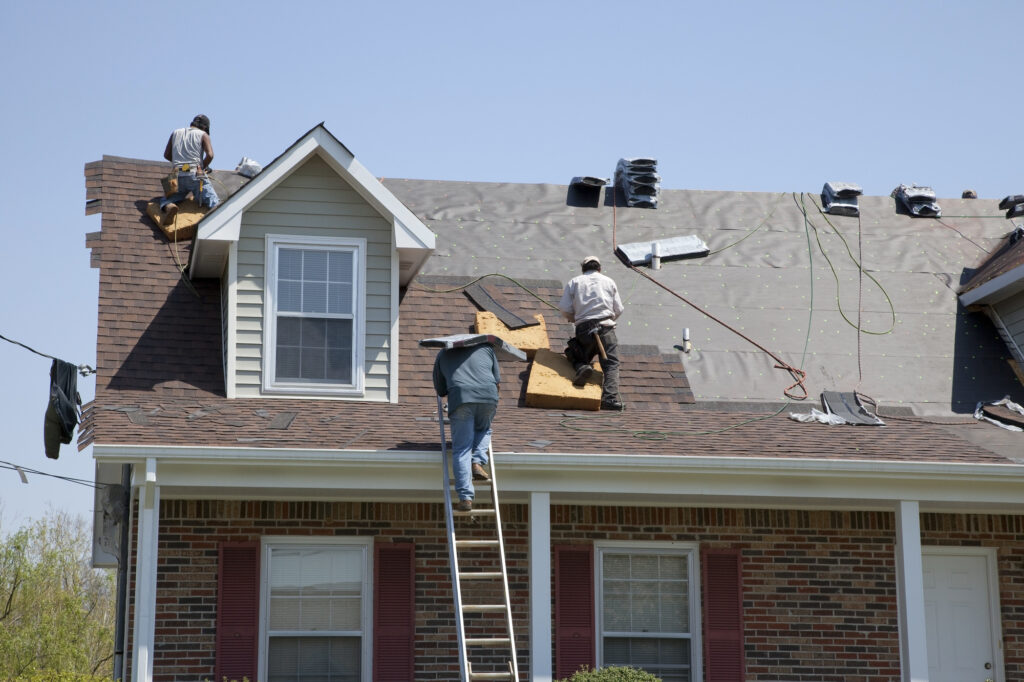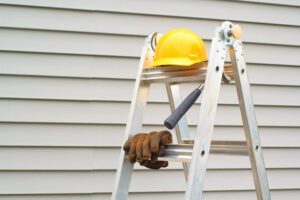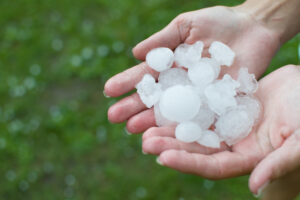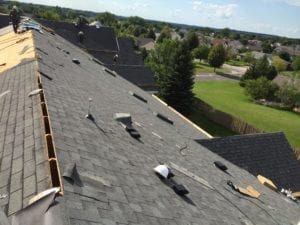Storm damage can compromise your roof’s integrity, requiring prompt attention. Look for signs such as missing shingles, granule loss, and leaks. After identifying damage, document everything with photos for insurance claims. Temporary fixes, like covering exposed areas with tarps and applying roofing cement, can help prevent further issues. When evaluating whether to repair or replace, consider the extent of damage and the age of your roof. Consulting an experienced contractor can clarify your options and guide you through the insurance process, ensuring you make informed decisions. Additional insights on effective recovery strategies await further exploration.
Signs of Storm Damage on Your Roof
Identifying signs of storm damage on your roof is essential for timely repairs and preventing further issues.
Key indicators of wind damage include torn or missing shingles, while hail damage is often evidenced by granule accumulation in gutters.
A thorough inspection of these elements can help determine the necessary steps to restore your roof’s integrity.
Wind Damage Indicators
Wind damage can manifest in various ways on a roof, making it vital for homeowners to recognize the signs early to prevent further deterioration and costly repairs.
Common indicators of wind damage include missing shingles, which can expose the underlayment and increase the risk of leaks. Homeowners should also look for creased or torn shingles, as well as missing granules that can lead to accelerated deterioration of roofing materials.
Furthermore, debris on the roof may suggest wind-driven impact damage. A thorough roof inspection is important to identify these issues.
If any signs of damage are present, a professional assessment is recommended to guarantee the roof’s structural integrity and to address any vulnerabilities effectively.
Hail Damage Indicators
After addressing wind damage indicators, it is important for homeowners to also recognize the signs of hail damage on their roofs, which can greatly compromise the roof’s integrity and longevity.
Key indicators of hail damage include visible round dents on shingles, often accompanied by granule loss, which diminishes the shingles’ protective capabilities. Homeowners should inspect for granules collected in gutters or at the roof’s base, as this suggests significant hail impact.
Furthermore, shingles may display cracks or fractures, particularly asphalt shingles, which are particularly vulnerable. Uneven coloration or shiny patches on shingles may indicate granule loss.
For a thorough assessment, it is advisable to consult a professional roofing contractor to address any detected damage promptly.
What to Do Immediately After Storm Damage
In the aftermath of storm damage, homeowners should prioritize documenting all visible damage to support their insurance claims.
Taking clear photos and notes of issues such as leaks and missing shingles is essential for a thorough assessment.
Furthermore, implementing temporary fixes, like using waterproof tarps, can help protect the home from further water intrusion until professional repairs are completed.
Documenting the Damage
Following a storm, it is essential to promptly document any visible roof damage to facilitate a smooth insurance claim process.
Start by taking clear photographs from multiple angles, ensuring that all damage is captured. Note specific details, such as the number of missing or damaged shingles, visible leaks in the attic or ceilings, and any structural issues like sagging areas.
Furthermore, create a detailed list of all affected areas, including gutters and flashing, and document any signs of water intrusion inside the home.
Record the date and time of the storm along with relevant weather reports for context.
Temporary Fixes for Immediate Protection
Prompt action is necessary to implement temporary fixes that provide immediate protection against further damage after documenting the extent of storm-related roof issues.
Begin by covering damaged areas with waterproof tarps, securing them with weights to prevent water infiltration. For minor leaks, apply roofing cement or epoxy to seal cracks and punctures temporarily.
Furthermore, promptly replace any missing shingles and secure loose ones with roofing nails to minimize further exposure to the elements. It is vital to avoid walking on the damaged roof to prevent exacerbating the situation.
Document all temporary repairs with photos and receipts, as this information will be essential when filing your insurance claim, ensuring you receive the necessary support for permanent repairs.
Deciding Between Roof Repair and Replacement
When deciding between roof repair and replacement, it is essential to assess the extent of the damage thoroughly.
A cost comparison, alongside an understanding of insurance implications, can greatly influence this decision.
Evaluating these factors guarantees homeowners make informed choices that safeguard their investment and property.
Assessing the Extent of Damage
Evaluating the extent of storm damage is essential in determining whether a roof requires repair or complete replacement.
Homeowners should begin by examining the damage through a visual inspection, looking for visible signs such as missing, cracked, or curled shingles. If water leaks or structural issues are evident in the attic or ceilings, these factors may indicate more severe damage.
A roof with isolated, minor damage may only require repair, while extensive damage or aging roofs—especially those over 20-30 years old—often necessitate replacement.
The type of roofing materials also plays a critical role; durable materials like metal or tile may withstand more damage than asphalt shingles.
Consulting a professional can provide clarity on the most cost-effective solution regarding roof repair cost.
Cost Comparison and Insurance Implications
Determining the most cost-effective approach between roof repair and replacement involves careful consideration of repair expenses, insurance coverage, and the roof’s age and condition.
Roof repairs generally range from $300 to $1,500, while a full roof replacement can cost $5,000 to $25,000 or more.
Homeowners should evaluate their storm damage claim and review their insurance policies, as coverage may vary. If repair costs approach the deductible, submitting an insurance claim for a full roof replacement may be financially advantageous.
Furthermore, roofs nearing the end of their lifespan are often better candidates for replacement instead of costly repairs.
Consulting with insurance adjusters can provide clarity on coverage specifics, aiding in informed decision-making throughout the claims process.
Navigating the Insurance Claim Process
Maneuvering the insurance claim process after storm damage is essential for homeowners seeking financial assistance for repairs.
Understanding the steps for filing a claim and effectively communicating with adjusters and contractors can greatly influence the outcome.
Proper preparation and documentation will streamline the process and help guarantee that you receive the coverage you deserve.
Steps for Filing a Storm Damage Claim
To successfully file a storm damage claim, homeowners should promptly contact their insurance company to report the damage and initiate the claims process.
Begin by using a storm damage checklist to document all visible damage, including taking photos and making notes of affected areas such as the roof and attic.
It is essential to call your homeowners insurance to file a claim as soon as possible, as delays can jeopardize coverage eligibility.
After reporting the damage, prepare for an insurance adjuster to inspect the damage on-site.
Be available to answer any questions and provide context about the situation.
Understanding your policy’s details will help manage expectations regarding coverage limits and deductibles before proceeding with repairs.
Working with Adjusters and Contractors
Effective collaboration with insurance adjusters and contractors is essential for ensuring a smooth claims process and achieving satisfactory repair outcomes after storm damage.
Homeowners should promptly contact their insurance provider to initiate the claim process and document visible damage with photographs.
An insurance adjuster will assess the damage on-site, and their detailed report determines whether the claim is approved.
It is critical to avoid hiring a roofing company until the claim is approved to prevent incurring out-of-pocket expenses for repairs that may be covered.
If the initial assessment leads to a denial, homeowners can request a different adjuster for a second opinion.
Understanding policy coverage limits and deductibles is crucial, as these factors influence repair costs covered by the insurer.
Choosing the Right Roofing Contractor for Storm Damage Repair
Selecting the right roofing contractor for storm damage repair is vital to guarantee quality and reliability.
Key qualities to take into account include experience with insurance claims and a solid reputation in the community, as these factors can greatly impact the repair process.
Moreover, being vigilant against storm chaser scams is essential to protect your investment and guarantee a successful repair experience.
Key Qualities to Look for in a Contractor
When choosing a roofing contractor for storm damage repair, it’s crucial to prioritize experience in handling the specific challenges posed by severe weather-related issues.
Look for contractors who specialize in storm damage repairs, as they will be well-versed in the unique requirements of such work.
Verify that the contractor possesses valid licensing and insurance, which safeguards you from potential liability and confirms compliance with local regulations.
Furthermore, review customer feedback on platforms like the Better Business Bureau and Google to assess their reputation and past performance.
Avoiding Storm Chaser Scams
Maneuvering the aftermath of a storm requires vigilance to avoid falling victim to storm chaser scams, which often target homeowners in distress with promises of quick and inexpensive repairs.
To protect your investment, seek out reputable roofing contractors with established local presence and proven track records. Avoid engaging with storm chasers who appear immediately after a storm; they typically lack proper credentials and may demand upfront payments without delivering quality work.
Always verify contractor’s references and reviews, focusing on customer experiences related to storm damage repairs. Furthermore, obtain multiple estimates to compare costs and services, guaranteeing you choose a reliable contractor who provides fair pricing and quality workmanship.
This diligence will safeguard you from potential scams and guarantee effective repairs.
Frequently Asked Questions
Does Homeowners Insurance Cover Roof Damage From Storms?
Homeowners insurance generally covers roof damage resulting from storms, such as hail and wind, under dwelling coverage. However, it is essential to review policy specifics for deductibles and limits to understand financial responsibilities accurately.
How Much Damage Does a Roof Need to Be Replaced?
A roof typically requires replacement if more than 30% of its shingles are damaged, indicating potential structural issues. Homeowners should evaluate visible deterioration, including sagging or extensive leaks, to determine replacement necessity effectively.
How Do Storm Damage Insurance Claims Work?
Storm damage insurance claims involve reporting the damage to your insurer, providing documentation, and having an adjuster assess the situation. Approval must be obtained before proceeding with repairs to guarantee coverage of expenses incurred.
Does Insurance Cover Shingles Blown off Roof?
Insurance coverage for shingles blown off a roof typically depends on the specific terms of the policy. Most homeowners’ insurance includes wind damage coverage, but exclusions and deductibles may apply, necessitating a thorough review of the policy.







